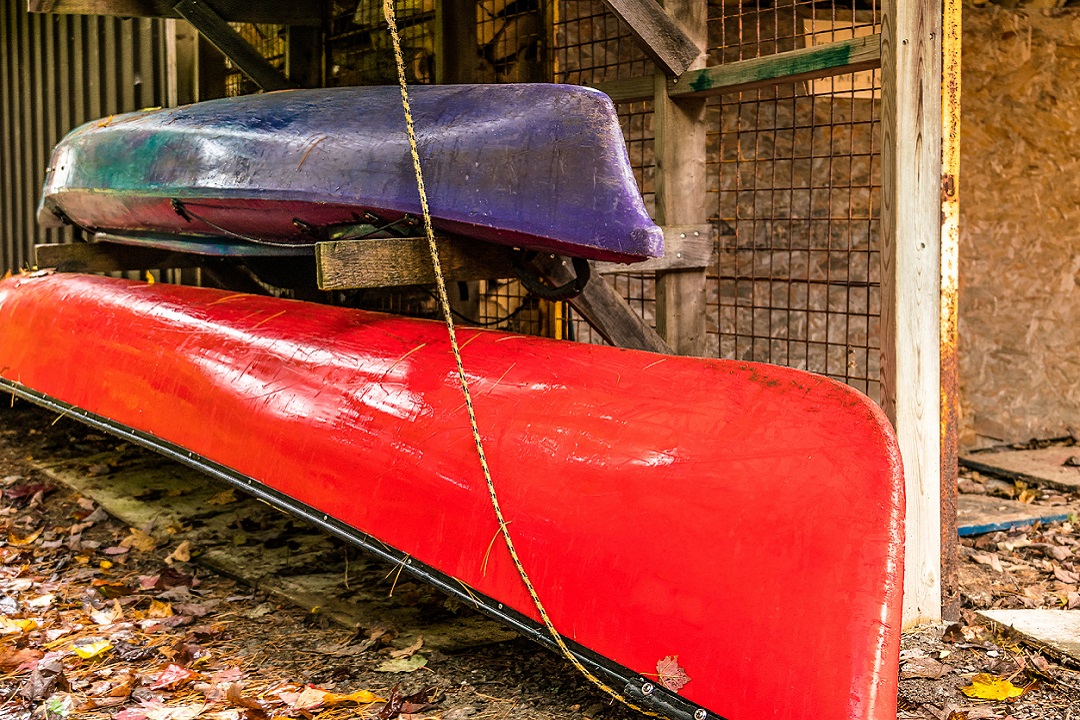It’s that time of year again. The leaves have fallen, the days are shorter, and the rivers have long since receded. For those outdoor enthusiasts who don’t enjoy braving the cold-weather months on the water, it’s time to stow the paddles and winterize your boats.
To put a positive spin on it, the key to a fun and successful 2020 paddling season is a properly repaired and winterized boat in 2019. What does that entail, exactly? We talked with Dave Haessig, president of the St. Louis Canoe & Kayak Club and former state director for the American Canoe Association, to get his suggestions on how to keep your watercraft river-ready during the harsh winter months.
Wash your boat inside and out. Be sure to get the undersides of decks, seats, and gunwales, along with digging into the nooks and crannies of storage compartments. “Soak all neoprene hatch covers in an odor remover and hang them to dry thoroughly before storing,” Haessig advised.
Identify signs of wear and tear. While washing your boat, look for loose bungees on kayak decks, frayed straps on canoe seats, seals coming loose on storage compartments, etc. Take the time to repair any potential failure points before they become a problem.
Tighten bolts and screws. You’ll want to tighten up any hardware that has worked itself loose over the course of the year — especially that which holds the craft together — but don’t overdo it. Over-tightening can break bolts and crack surfaces.
Inspect your steering/propulsion mechanism. Oil any friction/pivot points. “Spray lithium grease on the rudder and cables, being sure to work the rudder side to side,” Haessig recommended. Loosen any bungee systems to prevent cords from stretching out in the off-season.
Polish and apply sun protection. On fiberglass/Kevlar watercraft, an automotive polish will smooth out minor dings and scratches. In addition, a good coating of 303 Protectant will bring back the luster of your boat while also protecting it from harmful UV rays. Be sure to apply the protectant to the interior of your canoe as well.
Sand, oil, and/or varnish woodwork. Wood gunwales need to be thoroughly dried prior to applying a coat of oil or gunwale guard. The same goes for wood thwarts, ribs, seats, or yoke.
Storage Solutions
“Ideally, you should store your boat out of direct sunlight, as UV rays will damage polyurethane and gel coats,” said Haessig.

A good option is to suspend your vessel from the ceiling of your garage.
The best option is to house your boat in a weather-protected area, preferably off the ground. Sawhorses work well, as does suspending your watercraft from the ceiling of your garage. For canoes, make sure the weight is evenly distributed on the gunwales, and never store a canoe on its side, as it will bend and warp over time.
Loosen any hatches and compartment coverings. If you’re concerned about a winter pest problem, “place some moth balls in a container in the cockpit of your boat to prevent unwanted animals from taking up residence,” said Haessig.
You can also create a cockpit cover for your boat. “Get some screening from your local hardware store, cut a few sections to cover any openings, and secure with bungees or elastic. This will keep the critters out,” said Haessig.
Do not place any heavy objects on top of the vessel, as this can warp the hull and misshape the bottom over time.
If you must store your watercraft outside during the winter, ensure that both the boat and the covering are tied down and secure. Strong winds and winter storms can quickly flip and damage your boat.
When protecting a vessel with waterproof plastic or a tarp, do not allow the cover to be in direct contact with hull, as this can cause discoloration and long-term damage. “Tent” the tarp or plastic over the boat — water noodles work well — allowing air to flow underneath.
Last but not least, don’t forget about your paddles and gear. “Clean the ferrules of your paddle and spray them with a lubricant, then reassemble for storage,” said Haessig. “Soak and clean your neoprene gear and use a UV protectant on the gaskets of your dry suit. Powder it before storing for winter.”
Taking care of these small tasks now can prevent you from dealing with what has turned into a larger issue come next season. You may even be able to sneak in a paddle when a splash of sun and warm winds come early. There’s nothing like being the first one on the water!
Author: Nick Tilley is a regular contributor for Terrain Magazine.


Leave A Comment